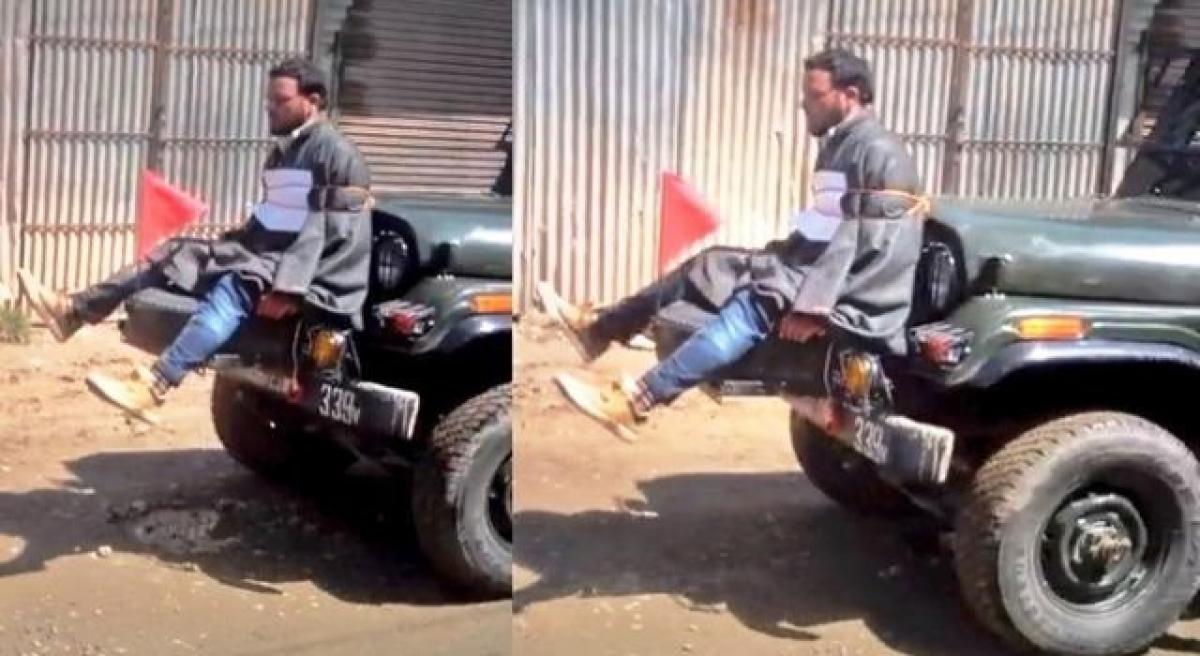Live
- 4 lakh challans issued for improper parking
- AP Govt. Employs Drones in Fight Against Cannabis Cultivation
- Metro to sell Trade Fair tickets at 55 stations
- Revise income limit for EWS admissions in pvt schools to `5 lakh: LG
- MCD mayoral election today: Satya reappointed as presiding officer
- Don’t fall in trap of drug addiction, youths cautioned
- Air Pollution Crisis: LG approves redeployment of Civil Defence volunteers
- Delhi police orders checking of hotels to nab criminals
- Kavya seeks people’s support for development of district
- Leaders remember People’s poet Kaloji
Just In

The storm over the use of a ‘human shield’ in Kashmir continues unabated with opinion sharply divided between those who defend it and those who see it as violation of human rights some calling it a ‘war crime’.
The storm over the use of a ‘human shield’ in Kashmir continues unabated with opinion sharply divided between those who defend it and those who see it as violation of human rights some calling it a ‘war crime’.
The Army Major who led the small group of soldiers on way to providing protection to voters at a polling booth has been commended by the Army Chief, defended by the government and many Indians while critics say that he was wrong in ordering that a ‘human shield’ be used as a protective measure against the stone-pelting crowd.
On the face of it, it will be hard to defend the use of ‘human shield’; no law or convention permits it and it cannot be justified on strict moral and ethical grounds. The ‘human shield,’ a Kashmiri weaver, has asked why was he tied to a jeep and paraded when he was going to cast his vote.
The other side of the story is that he was part of the stone-pelting crowd. Whatever the truth, it might be wrong to view the unfortunate incident only as a case of violation of any convention or law without linking it to the tragedy in Kashmir.
Had the situation in the troubled State been handled with any competence there would have been no need ever to use a ‘human shield.’ Those who have condemned the Army for using a ‘human shield’ seem to have woken up to the fact rather belatedly. Some might accuse them of being selective in condemning the incident and more specifically the Indian Army.
What do the stone-pelting crowds do if not act as ‘human shields’ to thwart security forces from carrying out genuine operations like flushing out terrorists? No law allows the crowd to prevent law enforcement or security agencies from carrying out their duty.
It may well be asked if the extent of injuries or even loss of human lives could have been considerably reduced had there been no ‘human shield’ of stone-throwers.
The security forces would have carried out their operation and left without harming those they were not looking for. During the episode of the controversial use of ‘human shield’ by the Indian Army it was noticed that it passed off without any harm to anyone.
It cannot be denied that there was every possibility of stone-pelting by the crowd had there been no ‘human shield.’ The Army would have almost certainly taken some defensive action in the face of stone-pelting. It could have been firing bullets which could have led to some regrettable loss of life.
Another surge in anger against the Army would have been inevitable. The use of a live human being as a shield worked for the safety of both the Army personnel and the angry stone-carrying local crowd, which otherwise always looks for an opportunity to counter the security forces with stone-throwing.
Had there been firing by the Army, resulting in human casualty, there would have been a far louder uproar.
But stone-throwers used as ‘human shield’ is not new to India and certainly not peculiar to Kashmir. Maoist insurgents have frequently used it.
According to media reports, extremists in India and many other parts of the world have not hesitated from using minors as possible shields. Israel has been accused of using ‘human shield,’ and so are the Palestinians.
The United Nations has condemned it. But that has apparently not prevented either side from using ‘human shield’ in the endless clashes between the Israeli forces and Palestinians. Judging from reactions and the heated debate in India, it will appear that the Indian Army will not be able to repeat in the future what it did in Kashmir in mid-April.
It will have to find some other ‘out of the box’ or ‘inexpensive’ ways of dealing with the stone-pelting crowds in Kashmir. One cannot say what exactly the other unconventional ways there are, but what needs to be emphasised is that not a day should be lost in finding a way to stop the situation in Kashmir from deteriorating further.
After all, ‘human shield’ and stone-pelting are matters that are directly connected to the situation there. ‘Exposing’ the separatist leaders of the Hurriyat as recipients of money from across the border is a welcome step, if it can help to weaken their hold over the stone-throwing crowds.
It may not be enough. The situation demands concerted efforts to break the present logjam and to enable the Kashmiri youth to realise their full potential – and to say good-bye to human shields.
By Rajeev Sharma

© 2024 Hyderabad Media House Limited/The Hans India. All rights reserved. Powered by hocalwire.com







